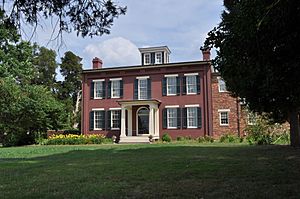Chippokes State Park facts for kids
Quick facts for kids Chippokes State Park |
|
|---|---|

Jones-Stewart House at Chippokes Plantation
|
|
| Lua error in Module:Location_map at line 420: attempt to index field 'wikibase' (a nil value). | |
| Location | Surry County, Virginia |
| Nearest city | Newport News |
| Area | 1,947 acres (787.9 ha) |
| Established | 1967 |
| Administered by | Virginia Department of Conservation and Recreation |
| Visitors | 173,110 (in 2020) |
|
Chippokes Plantation
|
|
| Area | 1,403 acres (567.8 ha) |
| Built | 1829 |
| Architectural style | Italianate |
| NRHP reference No. | 69000283 |
| Significant dates | |
| Added to NRHP | October 1, 1969 |
Chippokes State Park is a fun place to visit in Virginia. It sits right on the James River and is part of the Captain John Smith Chesapeake National Historic Trail. This park has lots of forests and a beach where you can even hunt for fossils!
You can explore three old houses and their smaller buildings. There's also an outdoor museum that shows what farming and forestry were like long ago. The park has a visitor center, a swimming pool, hiking trails, cabins, yurts, and campgrounds. In 2020, over 173,000 people visited Chippokes State Park. You can find it in Surry County, off Route 10.
Contents
A Look Back at Chippokes History
How Chippokes Got Its Name
The name Chippokes comes from Choapoke, a leader (called a weroance) of the Quiyoughcohannock people. These Native Americans were part of the Powhatan Paramount Chiefdom. Their lands were between two creeks, and they were skilled at farming, trading, and using the local rivers. By 1619, their lands were given to English settlers.
Early Owners of the Land
In 1619, Captain William Powell received 750 acres of land here. He was an "Ancient Planter," meaning he had lived at the Jamestown settlement for 10 years. After Powell died, the land passed through his family. Later, Governor William Berkeley owned Chippokes. When he passed away, his wife, Lady Frances Culpeper Berkeley, inherited it. She then married Philip Ludwell I.
The Ludwell family owned Chippokes Plantation for almost 150 years. They didn't live there but had people manage the farm. One famous Ludwell was Philip Ludwell III, who was the first known Orthodox Christian in America. His daughter, Lucy Ludwell Paradise, was friends with important figures like Thomas Jefferson.
The Jones Family and the Civil War Era
In 1837, Albert Carroll Jones became the first owner in centuries to actually live at Chippokes. He was a wealthy 22-year-old. He expanded the main house and planted fruit trees to make brandy. In 1850, he started building a grand new house, the Jones-Stewart Mansion.
During the Civil War, local stories say that Chippokes farm was saved from damage. This was because Jones supposedly provided his special beverages to both sides of the conflict! Before the war, Chippokes was a busy farm with 47 enslaved people working there. Jones died in 1882.
Becoming a State Park
In 1918, Victor Stewart and Thornton Jeffress bought Chippokes. They planned to cut down the trees for timber. However, Victor and his wife, Evelyn, fell in love with the place and decided to live there. They worked hard to restore the old mansion and its beautiful gardens.
Since they didn't have children, the Stewarts decided to give Chippokes Plantation to the Commonwealth of Virginia. Their wish was for it to become a public park. Chippokes Plantation State Park officially opened in 1970.
Chippokes Today: A Living Farm and Park
Chippokes Plantation is one of the oldest farms in North America that has been continuously farmed. It recently celebrated its 400th anniversary! As a State Park, it offers many fun activities. You can enjoy a swimming pool, visitor center, hiking trails, camping, and cabin rentals. Park rangers lead tours of the historic houses, guided hikes, and craft workshops.
The park is also famous for its riverfront area. Here, you can find many marine fossils from millions of years ago!
Chippokes Farm & Forestry Museum
The Chippokes Farm and Forestry Museum opened in 1990. It's an outdoor museum that shows what life was like for farmers in Tidewater Virginia from 1619 to 1950. You can see old farmhouse rooms, workshops of rural craftspeople, and traditional farm tools.
The museum also teaches about the importance of forestry (managing forests) in the area. You can even see heritage breed animals and a Cultural Garden. These exhibits help tell the story of Chippokes Plantation's long farming history. The museum is open for self-guided tours from March to December.
Walnut Valley Plantation
In 2004, Walnut Valley Plantation became part of Chippokes State Park. This 550-acre plantation was started in 1636. It has the oldest plantation house in the park, the Walnut Valley House, built around 1770.
Another important building is the restored 1816 slave quarter. It is one of the oldest remaining in Virginia. Today, the Walnut Valley House is a private lodge that you can rent.
Captain John Smith Chesapeake National Historic Trail
Since 2007, Chippokes State Park has been part of the Captain John Smith Chesapeake National Historic Trail. This trail is over 3,000 miles long and is the first national water trail in the United States. It follows the routes that Captain John Smith explored in the early 1600s.
See also

